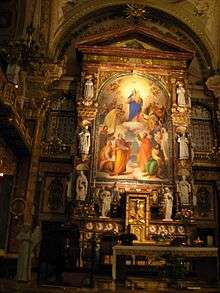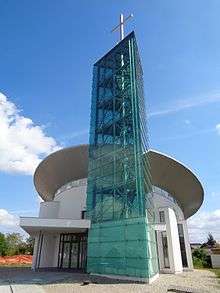Mary Help of Christians

Mary Help of Christians (Latin: Sancta Maria Auxilium Christianorum; Spanish: Nuestra Señora María Auxiliadora; Filipino: Maria, Mapag-ampon sa mga Kristiyano), is a Roman Catholic Marian devotion with a feast day celebrated on May 24. Saint John Chrysostom was the first person to use this Marian title in year 345 as a devotion to the Virgin Mary. Don Bosco also propagated Marian devotion under this title.
The title of Mary Help of Christians is associated with the defense of Christian Europe (Latin and Greek), the north of Africa and the Middle East from non-Christian peoples during the Middle Age. In 1572, the Islamic Ottoman Empire intended to invade Christian Europe. Pope Pius V called Christian armies from all over Europe to defend the continent and asked the believers to pray to Mary in order. The defeat of the Muslim Turks was attributed to the intercession of Mary under this title.
Pope Leo XIII granted a Canonical coronation towards the Marian image bearing the same title on 17 May 1903, now presently enshrined within the Basilica of Mary Help of Christians. Pope Benedict XVI during his Regina Caeli papal address on 24 May 2009 invoked this Marian patronage, under the venerated title of Our Mother of Sheshan, calling for Chinese Catholics to renew their fidelity to the Pope as the sole successor of Saint Peter.[1]
History
Patristic origins
There are two inscriptions of the first centuries of Christianity in Greek related to the Virgin Mary: : θεοτοκος (Teotokos, Theotokos, Mother of God) and βοηθεια (Boetheia, the Helper). The Fathers of the Church referred to Mary as "βοηθεια". John Chrysostom used the title in a homily of 345, Proclus in 476 and Sebas of Caesarea in 532. After the Patristic period (5th century), other persons used it like Romanos the Melodist in 518, the Patriarch of Jerusalem, Sophronius in 560, John of Damascus in 749 and German of Constantinople in 733.
In the view of Fr. Johann G. Roten, SM, the invocation of Mary as Help of Christians is part of the oldest prayer addressed directly to Mary, the Sub tuum praesidium, which was found on a papyrus dating, at the latest, from the end of the 3rd century. Praesidium is translated as "an assistance given in time of war by fresh troops in a strong manner."[2]
Litany of Loreto
Around 1576, Bernardino Cirillo, archpriest of Loreto, published at Macerata two litanies of the Blessed Virgin, which, he contended, were used at Loreto. One is in a form which is entirely different from our present text. Another form ("Aliae litaniae B.M.V.") is identical to the litany of Loreto approved by Pope Clement VIII in 1601 and now used throughout the entire Church. This second form contains the invocation Auxilium Christianorum. Possibly warriors returning from the Battle of Lepanto (October 7, 1571) visited the sanctuary of Loreto, and saluted the Holy Virgin there for the first time with this new title. It is more probable, however, that it is only a variation of the older invocation Advocata Christianorum, found in a litany of 1524.[3]
Torsellini (1597) and the Roman Breviary (May 24, Appendix) say that Pope Pius V inserted the invocation in the litany of Loreto after the battle of Lepanto. But the form of the litany in which it is first found was unknown at Rome at the time of Pius V.[4]
Feast of Our Lady Help of Christians

The feast of Our Lady, Help of Christians, was instituted by Pope Pius VII. By order of Napoleon I of France, Pius VII was arrested on June 5, 1808, and detained a prisoner first at Grenoble, and then at Fontainebleau.[5] In January 1814, after the battle of Leipzig, he was brought back to Savona and set free on March 17, on the eve of the feast of Our Lady of Mercy, the Patroness of Savona. The journey to Rome was a veritable triumphal march. The pontiff, attributing the victory of the Church after so much agony and distress to the Blessed Virgin, visited many of her sanctuaries on the way and crowned her images (e.g., the "Madonna del Monte" at Cesena, "della Misericordia" at Treja, "della Colonne" and "della Tempestà" at Tolentino). The people crowded the streets to catch a glimpse of the venerable pontiff who had so bravely withstood the threats of Napoleon. He entered Rome on May 24, 1814, and was enthusiastically welcomed.[6] To commemorate his own sufferings and those of the Church during his exile Pope Pius VII extended the feast of the Seven Dolours of Mary to the universal Church on September 18, 1814.
When Napoleon left Elba and returned to Paris, Murat was about to march through the Papal States from Naples; Pius VII fled to Savona 22 March 1815.[3] After the Congress of Vienna and the battle of Waterloo, the Pope returned to Rome on July 7, 1815. To give thanks to God and Our Lady, on 15 September 1815 he declared 24 May, the anniversary of his first return, to be henceforth the feast of Our Lady, Help of Christians; the 1913 Catholic Encyclopaedia article commented that it has spread nearly over the entire Latin Church, but is not contained in the universal calendar.


The Marian feast was celebrated by the order of Servites since the 17th century. The veneration to Mary became popular under this title in Rome especially, where the feast was especially promulgated by Saint John Bosco and Saint Vincent Pallotti[7] St. John Bosco was an ardent promoter of devotion to "Mary, Help of Christians". He even built a huge Basilica in her honour in 1868 and founded a religious Congregation for women, under the title of, "The Daughters of Mary, Help of Christians".
Vatican II, in the Constitution on the Church (sections 61, 62), cites this title of Mary, placing it in the context of Mary's maternal role. "In an utterly singular way she co-operated by her obedience, faith, hope and burning charity in the Saviour's work of restoring supernatural life to souls. For this reason she is a mother to us in the order of grace…By her maternal charity, Mary cares for the brethren of her Son who still wander through this world in the midst of dangers and difficulties until they are led to the happiness of their heavenly home".[8]
Observance

The Church has traditionally focused on two aspects of Our Lady's help on this feast day. Firstly, the Church focuses in this feast upon the role of Our Lady's intercession in the fight against sin in the life of a believer. Secondly, the Church has focused upon Our Lady as one who assists Christians as a community, through her intercession, in fighting against anti-Christian forces.
Michael Daniel observes that while this approach may be regarded as outdated, in light of Vatican II, where the world and non Christians elements therein were seen in a positive rather than a hostile or threatening light, it would seem that it would be naïve on the part of Christians to regard all movements and all social trends as either good or harmless.[8]
The dioceses of Tuscany adopted it on February 12, 1816. The hymns of the Office were composed by Brandimarte.[9]
It became the patronal feast of Australasia, a double of the first class with an octave;[10] after the reforms of the Second Vatican Council, it was designated a Solemnity, to be kept on the first available Sunday on or after 24 May.
The Fathers of the Foreign Missions of Paris, in accordance with a vow (1891), celebrated this feast with great splendor in their churches.
It has attained special renown since Don Bosco, founder of the Salesian Congregation, dedicated his foundation to Our Lady, Help of Christians, the mother church of his congregation at Turin on June 9, 1868. The Salesians have carried the devotion to their numerous establishments.
It was established due to the great appreciation of Saint Don Bosco for this Marian title and the development of the Salesian works in many countries since the second half of the 19th century. Although it is commonly associated with the Roman Catholic Church, the Orthodox Church has also known the devotion since 1030 in Ukraine, when the country was defended from a barbarian invasion.
The Salesian National Shrine of Our Lady Help of Christians is located in Stony Point, New York.[11]
The Abbey of Mary Help of Christians, better known as Belmont Abbey, is a small American monastery of Benedictine monks in the town of Belmont, Gaston County, North Carolina, outside of Charlotte, North Carolina. The minor basilica of Our Lady Help of Christians is listed on the National Register of Historic Places.[12]
There is a chapel of Our Lady Help of Christians at the Basilica of the Immaculate Conception in Washington D.C.[13]
Under this title, the Virgin Mary is venerated by many Chinese Catholics, particularly at the Shrine of our Lady of Sheshan. In May 2007, Pope Benedict XVI designated her May 24 feast for the Roman Catholics in China, who face persecution and restriction from the Chinese Patriotic Catholic Association.
Novena
O Mary, most holy, I greet you as my gracious Queen and thank you for the countless blessings you have been showering on all those who come to you for help (mention your prayer request). Mary, powerful Virgin, you are the mighty and glorious protector of the Church. You are the marvellous help of Christians.You are awe-inspiring as an army in battle array. You eliminated heresy in the world. In the midst of my anguish, struggle and distress, defend me from the power of the enemy, and at the hour of my death receive my soul in heaven. I ask this through Christ our Lord. Amen.
Artistic representations
 Mariahilf. Lucas Cranach the Elder, c. 1520, Cathedral of St. Jakob in Innsbruck
Mariahilf. Lucas Cranach the Elder, c. 1520, Cathedral of St. Jakob in Innsbruck Statue at the shrine of Our Lady Help of Christians, Federal District, Mexico
Statue at the shrine of Our Lady Help of Christians, Federal District, Mexico- Altar at Mariahilf church Vienna
- 18th-century painting at Matzleinsdorf church, Austria
See also
| Wikimedia Commons has media related to Mary Help of Christians. |
Notes
- ↑ Benedict XVI. Church in China, renew your fidelity to Peter on YouTube
- ↑ Rotan SM, Johann G., "Help of Christians", University of Dayton
- 1 2 Holweck, Frederick. "Feast of Our Lady, Help of Christians." The Catholic Encyclopedia. Vol. 11. New York: Robert Appleton Company, 1911. 9 Mar. 2013
- ↑ See LITANY OF LORETO; Schuetz, "Gesch. des Rosenkranzgebets", Paderborn, 1909, 243 sq.
- ↑ "Mary Help of Christians", Catholic News Agency
- ↑ McCaffrey, "History of the Catholic Church in the Nineteenth Cent.", 1909, I, 52
- ↑ Remigius Bäumer et al. Marienlexikon 1994, p. 533
- 1 2 Daniel, Michael. "Our Lady Help of Christians"
- ↑ Chevalier, "Repert. Hymnolog.", II, 495
- ↑ Ordo Australasiae, 1888
- ↑ National Shrine of Our Lady Help of Christians
- ↑ Basilica of Mary, Help of Christians
- ↑ Chapel of Our Lady Help of Christians, Basilica of the Immaculate Conception, Washington D.C.
